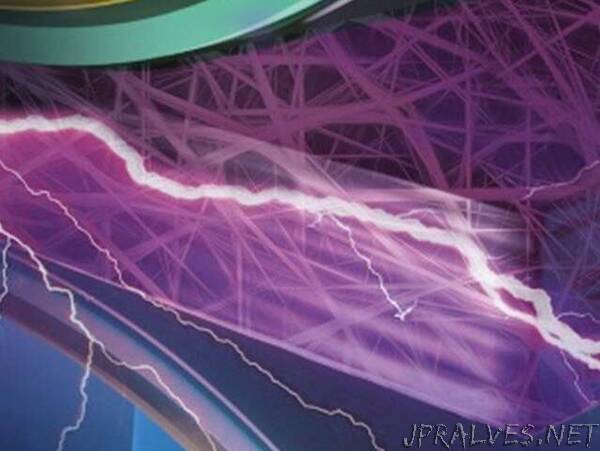
“Nylon might seem the obvious go-to material for electronic textiles—not only is there an established textiles industry based on nylon, but it conveniently has a crystalline phase that is piezoelectric—tap it and you get a build-up of charge perfect for pressure sensing and harvesting energy from ambient motion.
Unfortunately, forming nylon into fibers while getting it to take on the crystal structure that has a piezoelectric response is not straightforward. “This has been a challenge for almost half a century,” explains Kamal Asadi, a researcher at the Max-Planck Institute for Polymer Research, Germany, and professor at the University of Bath, U.K. In a recent Advanced Functional Materials report, he and his collaborators describe how they have now finally overcome this.
The piezoelectric phase of nylon holds appeal not just for electronic textiles but all kinds of electronic devices, particularly where there is demand for something less brittle than the conventional piezoelectric ceramics. However, for decades, the only way to produce nylon with the crystalline phase that has a strong piezoelectric response has been to melt it, rapidly cool it and then stretch it so that it sets into a smectic δ’ phase. This produces slabs typically tens of micrometers thick—far too thick for applications in electronic devices or electronic textiles.
The presence of piezoelectric behavior stems from the amide moieties on the repeating units in a nylon polymer chain, and their interaction with those on the neighboring chain. When these amides are free to align their dipoles with an electric field, it is possible to exploit the piezoelectric effect in the material, as first observed as far back as the 1980s. However, what happens in most of the nylon’s crystalline phases is that these amides form strong hydrogen bonds with amides on other polymer chains that lock them in position, preventing them from reorienting and aligning. The challenge was thus to find a way to produce the phase that left the amides free to reorient but was not so limited in the morphologies it can produce as the melt, cool and stretch approach.
Clean success
While most research groups around the world had abandoned efforts to produce piezoelectric films or fibers by the 1990s, the arrival in Asadi’s group of a “brilliant student who was a textile engineer”—Saleem Anwar—prompted Asadi to take a look at the problem. The researchers began by considering the essential factors for producing nylon in a phase with strong piezoelectric properties. The melt, cool and stretch approach hinges on rapidly cooling the nylon so Asadi and Anwar and their collaborators looked at how they could get the same effect by dissolving the nylon in a solvent and then rapidly extracting that solvent. However the solvents tend to dissolve the nylon by attacking the hydrogen bonds between the amides, and forming hydrogen bonds in their place, so that it is then nigh on impossible to get rid of the solvent.
The breakthrough came one day when Anwar told Asadi of a strange observation while cleaning up with acetone after an experiment in which he had tried to produce nylon films using trifluoroacetic acid (TFA) as the solvent. The nylon solution spills had turned transparent. Suspecting the sudden transparency must indicate a reaction was taking place, the team made a solution from TFA and acetone and tried processing nylon from it. Sure enough, the following week, “Saleem came back with his ‘eureka’ moment – ‘I have it!’” says Asadi.
What Anwar had stumbled on was the hydrogen bond between acetone and TFA, which is among the strongest hydrogen bonds known to science. So when the researchers laid the solution on a substrate in high vacuum to evaporate the solvent, as Asadi puts it, “It’s literally like the acetone takes the hand of the TFA molecules and carries them out of the nylon, yielding the piezoelectric crystalline phase.”
Fiber sweet spot
The researchers were the first to produce thin films of nylon with a strong piezoelectric response. But that didn’t quite resolve the issue of producing fibers, as the production methods were still incompatible with a high vacuum. So they looked at other ways they could control the solvent extraction rate. They focused on producing fibers by electrospinning, in which an electric field draws a polymer solution into fibers with diameters that can be as small as tens of nanometres wide, where the high surface-area-to-volume ratio of the fiber yields a high solvent extraction rate. The trick was then to balance this with the viscosity of the polymer solution and the electrospinning conditions so that other factors did not get in the way of the fiber forming in the prized δ’ phase.
The researchers found a sweet spot between the competing factors for fibers around 200 nm wide. Measurements of the potential generated under a periodic mechanical impact at a frequency of 8 Hz showed that the 200 nm δ’-phase fibers generated 6 V, whereas the narrower fibers produced less than 0.6 V because factors associated with the narrowness at these widths led to the fibers forming in a phase with no piezoelectric response.
In fact, in wider fibers around 1000 nm, the nylon formed in a γ crystalline phase, which has only a weak piezoelectric response, because the fibers were too thick for effective rapid solvent extraction. The poorer piezoelectric response of the γ phase in the thicker fibers was in some ways compensated by the larger volume of the fibers leading to the generation of potentials of 4V. However, the 200nm δ’ phase fibers still had the advantage of a more sensitive response.
The sensitivity of the wires to tapping suggests an exciting range of possible applications, from biometric monitoring such as pulse measurements, to a device that could allow you to charge your mobile phone just by walking around in your nylon apparel.”
